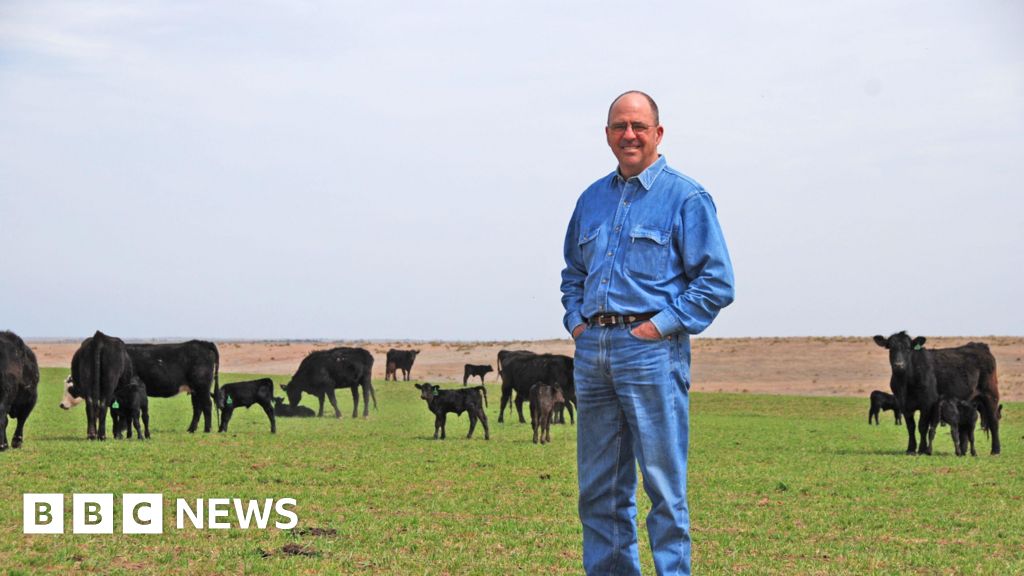Danielle KayeBusiness reporter
 Mike Callicrate
Mike CallicrateBeef prices have gotten so high in the US that it has become a political problem.
Even Donald Trump, who long ago declared inflation “dead”, is talking about it, as the issue threatens to undercut his promises to bring down grocery prices for Americans.
This week, he took to social media, urging ranchers to lower prices for their cattle.
But his demand – and other proposals his administration has floated to address the issue – has sparked a backlash among ranchers, who worry some of his solutions will make it harder for them to make a living, while making little dent at the grocery store.
The number of beef cattle farmers and ranchers in the US has dwindled steadily since 1980, reducing domestic supplies and driving up prices, as demand remains high.
The country’s cattle inventory has fallen to its lowest level in nearly 75 years, while the US has lost more than 150,000 cattle ranches just since 2017 – a 17% drop, according to the Agriculture Department.
Ranchers say they are under pressure from four decades of consolidation among the meat processors that buy their livestock, while high costs for key inputs like fertiliser and equipment have intensified the strain.
The contraction in the industry has worsened, as several years of drought have forced ranchers to slash their herds.
Christian Lovell, a cattle rancher in Illinois, said parts of his farm that were lush and grassy when he was a child have now dried up, limiting where his cows can graze.
“You put all these together and you have a recipe for a really broken market,” said Mr Lovell, who works with advocacy group Farm Action.
Beef inflation
Retail prices for ground beef rose 12.9% over the 12 months to September, and beef steaks were up 16.6%, according to US inflation data published Friday by the Bureau of Labor Statistics.
A pound of ground chuck now costs an average of $6.33 (£4.75), compared with $5.58 a year ago.
The increases have significantly outpaced general food inflation, which stood at 3.1%.
“The cattle herd has been getting smaller for the last several years, yet people are still wanting that American beef – hence the high prices,” said Brenda Boetel, a professor of agricultural economics at the University of Wisconsin, River Falls.
Derrell Peel, a professor of agricultural economics at Oklahoma State University said he expected prices to remain elevated until at least the end of the decade, noting that it takes years to replenish herds.
The Trump administration’s “hands are tied” when it comes to interventions that will help lower prices, Mr Peel added.
 Reuters
Reuters‘Chaos’ for American producers
The Agriculture Department this week unveiled what it called a “big package” aimed at ramping up domestic beef production, by opening more land for cattle grazing and supporting small meat processors.
That proposal came after Trump drew the ire of ranchers when he proposed to import more beef from Argentina, potentially quadrupling the purchases.
Eight House Republicans responded with a letter to the White House expressing concern about Trump’s import plans.
Even the National Cattlemen’s Beef Association, which has voiced support for Trump’s policies in the past, said the import plan “only creates chaos at a critical time of the year for American cattle producers, while doing nothing to lower grocery store prices”.
Trump responded by assuring farmers that he was helping them in other ways, noting tariffs that are limiting imports from Brazil.
“It would be nice if they would understand that, but they also have to get their prices down, because the consumer is a very big factor in my thinking, also,” Trump wrote.
But that has failed to quell the furore.
Justin Tupper, president of the US Cattlemen’s Association, said he thought that only the big four meat packers would benefit from Trump’s import plan.
“I don’t see that lowering prices here at all,” Mr Tupper said.
‘These are consolidated markets’
Some say the government could make an impact if it focused on the way a handful of companies dominate the market for meat processing.
Today, just four companies control more than 80% of the beef slaughtering and packing market.
“These are consolidated markets gouging ranchers and gouging consumers at the store,” said Austin Frerick, an agricultural and antitrust policy expert and a fellow at Yale University.
The meat processing firms – Tyson, JBS, Cargill and National Beef – have faced several lawsuits, including one filed by McDonald’s alleging they colluded to inflate the price of beef.
Though Trump revoked a Biden-era order earlier this year that directed agencies to tackle corporate consolidation across the food system, his administration has taken other steps to investigate competition issues in the agricultural industry.
‘We’re not going to rebuild this cow herd’
Mike Callicrate runs a cattle ranch in St Francis, Kansas. He said the only way he has managed to stay in the industry was by cutting out the middleman and setting up his own stores to reach consumers directly.
But Mr Callicrate acknowledged that most ranchers do not have the money to make that shift. Many have left the industry – and see no incentive to jump back in.
“We’re not going to rebuild this cow herd – not until we address market concentration,” Mr Callicrate said.
He said he supported the Agriculture Department’s plans to open up more cattle grazing land to boost production and bring down retail prices.
“But unless we have a market,” he added, you’re a “fool to get into the cattle business”
 Bill Bullard
Bill BullardBill Bullard found himself in the first wave of ranchers pushed out as the meat processing industry started to consolidate in the early 1980s.
He closed down his 300-cow operation in South Dakota in 1985.
Mr Bullard, who is now the chief executive of R-CALF USA, a cattle producer trade association, said it was only in the last year or so that ranchers had received good prices for their livestock, as supply dropped to such a low level that the prices paid by meat processors “simply had to increase”.
Still, reliance on imports and meat packers’ buying power persist, Mr Bullard said, meaning ranchers “lack confidence in the integrity of the marketplace” and remain reluctant to grow their herds.
He said he did not have confidence that the president’s ideas would fix the issues.
“He’s focused on the symptoms and not the problems,” he said.

